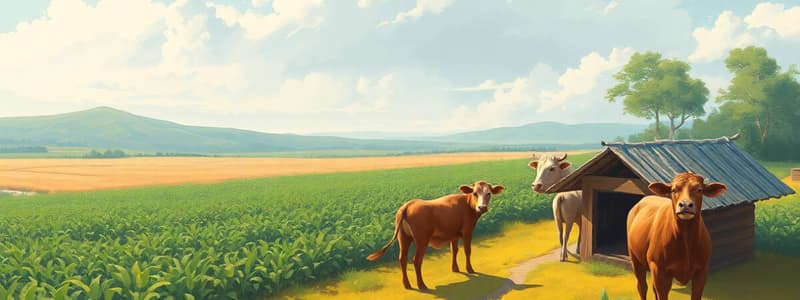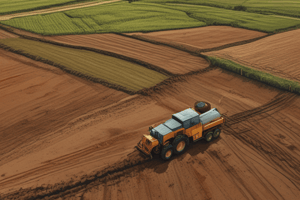Podcast
Questions and Answers
How does climate change most significantly challenge agricultural production?
How does climate change most significantly challenge agricultural production?
- By causing extreme weather events, temperature variations, and altered weather patterns. (correct)
- By reducing the need for technological advancements in farming.
- Through regular and predictable weather patterns that optimize crop yields.
- By increasing the availability of arable land.
What is the primary environmental concern associated with pesticide and fertilizer runoff in agriculture?
What is the primary environmental concern associated with pesticide and fertilizer runoff in agriculture?
- It enhances the biodiversity of aquatic ecosystems.
- It reduces the overall demand for water resources in agriculture.
- It causes water pollution, harming aquatic life and human health. (correct)
- It leads to improved soil structure and fertility.
What role do technological advancements play in addressing the challenges facing modern agriculture?
What role do technological advancements play in addressing the challenges facing modern agriculture?
- They support increased efficiency and sustainability, helping to counter climate change impacts and rising demand. (correct)
- They exacerbate the negative environmental consequences of agriculture.
- They are primarily focused on reducing the need for human labor, with little impact on climate change.
- They are unnecessary due to the effectiveness of traditional farming methods.
What does the concept of 'climate-smart agriculture' primarily involve?
What does the concept of 'climate-smart agriculture' primarily involve?
What is the likely impact of increasing global population on agricultural systems?
What is the likely impact of increasing global population on agricultural systems?
How does intensive agriculture contrast with extensive agriculture?
How does intensive agriculture contrast with extensive agriculture?
Which factor most directly influences the suitability of a region for specific crops?
Which factor most directly influences the suitability of a region for specific crops?
In regions experiencing limited rainfall, what agricultural practice is critical for successful crop production?
In regions experiencing limited rainfall, what agricultural practice is critical for successful crop production?
Which of the following is an example of precision agriculture?
Which of the following is an example of precision agriculture?
A farmer decides to switch from conventional farming to organic farming. Which action would support this transition?
A farmer decides to switch from conventional farming to organic farming. Which action would support this transition?
How do economic factors influence agricultural practices?
How do economic factors influence agricultural practices?
Which agricultural practice is most directly linked to deforestation and habitat loss?
Which agricultural practice is most directly linked to deforestation and habitat loss?
What role does technology play in modern agriculture?
What role does technology play in modern agriculture?
Flashcards
Water pollution
Water pollution
Contamination of water bodies due to harmful substances like pesticides and fertilizers.
Soil degradation
Soil degradation
Deterioration of soil quality caused by improper farming practices leading to erosion.
Increased demand
Increased demand
The necessity for higher agricultural output due to a growing global population.
Climate-smart agriculture
Climate-smart agriculture
Signup and view all the flashcards
Precision and automation
Precision and automation
Signup and view all the flashcards
Agriculture
Agriculture
Signup and view all the flashcards
Subsistence agriculture
Subsistence agriculture
Signup and view all the flashcards
Commercial agriculture
Commercial agriculture
Signup and view all the flashcards
Intensive agriculture
Intensive agriculture
Signup and view all the flashcards
Organic agriculture
Organic agriculture
Signup and view all the flashcards
Factors influencing agriculture
Factors influencing agriculture
Signup and view all the flashcards
Crop production practices
Crop production practices
Signup and view all the flashcards
Environmental impacts of agriculture
Environmental impacts of agriculture
Signup and view all the flashcards
Study Notes
Introduction to Agriculture
- Agriculture encompasses the art and science of cultivating the soil, growing crops, and raising livestock.
- It is a fundamental human activity that underpins food security and economic development.
- Agriculture involves complex interactions between humans, plants, animals, and the environment.
Types of Agriculture
- Subsistence agriculture: Primarily for the farmer's needs, with little surplus for trade. Common in developing countries with limited market access.
- Commercial agriculture: Purposeful production of crops and livestock for sale, with significant surplus, often specialized in certain commodities. Dominates developed nations and large parts of developing nations with market access.
- Intensive agriculture: Maximizes output from a small area using high inputs like fertilizers, pesticides, and irrigation.
- Extensive agriculture: Uses large areas of land with relatively low input use per unit area, allowing for lower yields, but greater total production.
- Organic agriculture: Focuses on sustainable practices like natural pest control, crop rotation, and natural fertilizers, minimizing synthetic inputs and maximizing soil health.
Factors Influencing Agriculture
- Climate: Temperature, rainfall, and sunlight directly affect crop growth and livestock productivity.
- Soil types: Different soil compositions dictate crop suitability and soil management practices.
- Water availability: Crucial for crop production and livestock in areas with limited rainfall, requiring irrigation.
- Technology: Advancements in machinery, genetics, and data management influence production efficiency and output.
- Economic factors: Market prices, government policies, subsidies, and access to credit impact farming decisions.
- Social factors: Labor availability, expertise, and tradition influence farming practices and resource allocation.
Agricultural Practices
- Crop production: Includes sowing, planting, irrigation, fertilizing, pest control, and harvesting.
- Livestock management: Involves breeding, feeding, housing, and health care of animals.
- Soil management: Practices to maintain soil fertility, structure, and water holding capacity.
- Pest and disease control: Strategies to prevent or manage infestations and diseases.
- Agricultural mechanization: Use of machinery for farming operations.
- Precision agriculture: Utilizing digital technologies and data to optimize resource use and farm management.
Environmental Impacts of Agriculture
- Greenhouse gas emissions: Agriculture contributes to greenhouse gas emissions, especially from livestock and fertilizer use.
- Deforestation: Clearing land for agricultural expansion contributes to habitat loss and biodiversity decline.
- Water pollution: Pesticide and fertilizer runoff pollute water bodies, harming aquatic life and human health.
- Soil degradation: Improper farming practices lead to soil erosion and loss of nutrients.
Global Agricultural Trends
- Increased demand: Growing global population increases pressure on agricultural systems to increase production.
- Climate change impacts: Changing weather patterns, extreme weather events, and temperature variations challenge agricultural production.
- Technological advancements: Continued research and development are needed to address climate change impacts and rising demand.
- Sustainable agriculture: Growing emphasis on increasing productivity while minimizing negative environmental consequences.
Challenges Facing Agriculture
- Climate variability: Changing weather patterns affect crop yields and livestock productivity.
- Water scarcity: Limited water availability restricts agricultural production in many regions.
- Pest and disease outbreaks: Infestations can destroy crops and livestock.
- Socio-economic issues: Poverty, lack of access to education and technology.
Future of Agriculture
- Precision and automation: Continued advancements in technology improve efficiency and sustainability.
- Sustainable practices: Focus on minimizing environmental impact.
- Climate-smart agriculture: Adaptations and strategies address climate change impacts.
- Biotechnology: Potential to enhance crop yields and quality.
- Supply chain efficiency: Optimizing transportation and distribution.
Studying That Suits You
Use AI to generate personalized quizzes and flashcards to suit your learning preferences.




